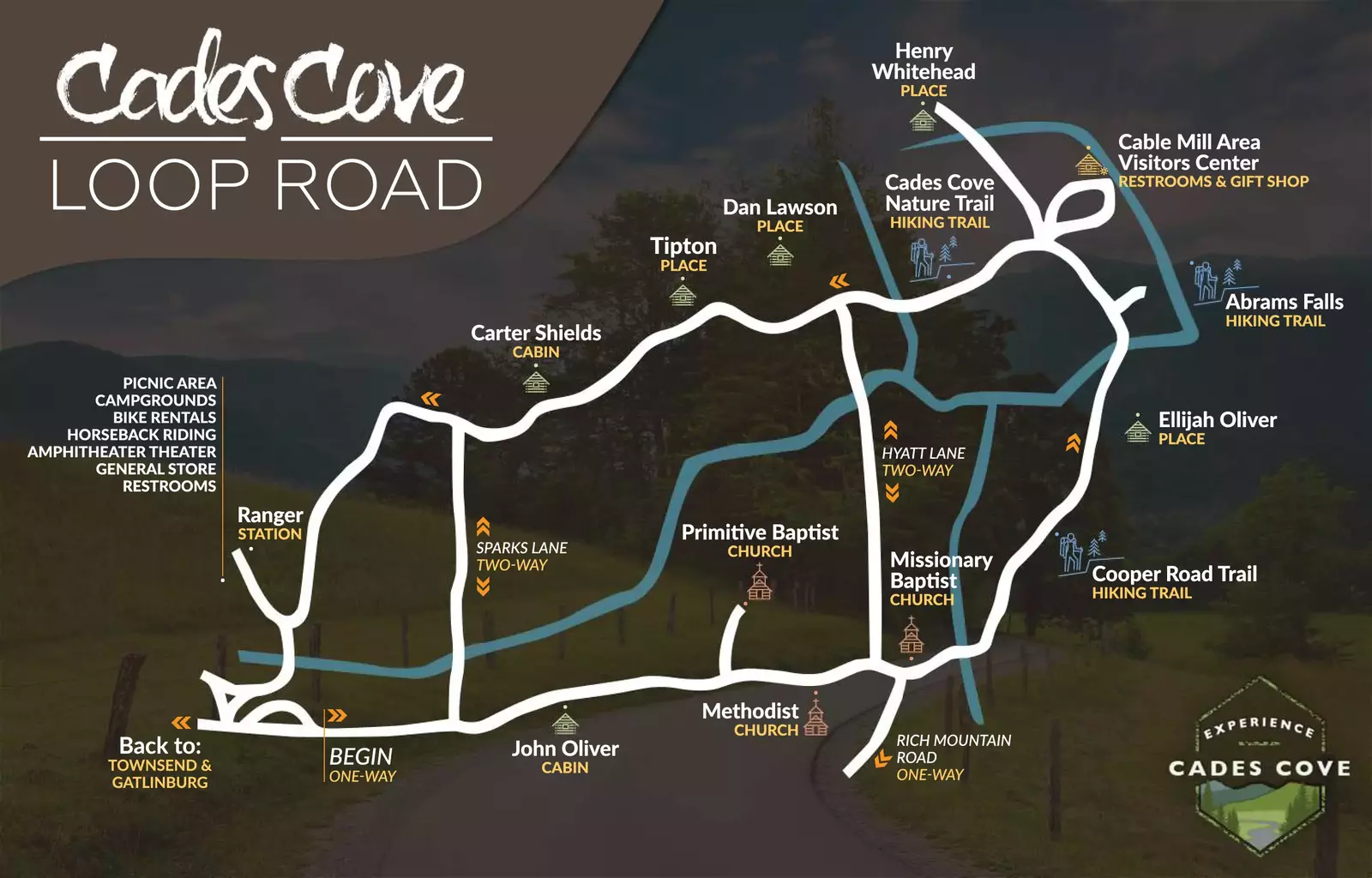Cades Cove Loop Road Directions & Map
Cades Cove isn’t hard to find! There is only one entrance to the Cades Cove Loop Road, which you can get to from Laurel Creek Road.
Download and Print Map
The Cades Cove Loop Road is one of the most traveled roads in the Smoky Mountains. This 11-mile, one-way loop takes visitors back in time to give you a glimpse of Smoky Mountain history. Along the Cades Cove Loop, you have the chance to see historic structures, gorgeous views, and wildlife.

Cades Cove isn’t hard to find! There is only one entrance to the Cades Cove Loop Road, which you can get to from Laurel Creek Road.
Download and Print Map
Follow the main Parkway to the Great Smoky Mountains National Park. Take a right on Little River Road after the Sugarlands Visitor Center. You’ll remain on Little River Road for about 20 miles, where the road then leads into Cades Cove.
Follow the Pigeon Forge Parkway into Gatlinburg and to the Great Smoky Mountains National Park. Then, follow the Gatlinburg directions to Cades Cove. Or, you can take Wears Valley Road to Townsend and use the Lyon Springs Road entrance to the national park. Then, use Little River Road to reach Laurel Creek Road and Cades Cove.
The Cades Cove Loop Road is open year-round, weather permitting, from sunrise until sunset.
Are you wondering what to expect when you visit Cades Cove? There are plenty of things to see along the Cades Cove Loop Road! Here are the top sights to keep your eyes out for in Cades Cove:

The John Oliver Cabin is the first structure visitors see along the Loop. It’s named after one of the first pioneers to move to Cades Cove and is held together mostly by gravity. The notched corners don’t have any nails or pegs holding them together.
There are three historic churches along the Cades Cove Loop Road. The first one you'll see is the Primitive Baptist Church, which was actually the second church that was built in Cades Cove. The second is the Methodist Church. Methodists in Cades Cove wanted a place to worship of their own, and the church was built in the 1820s. The Missionary Baptist church was formed in 1839 when part of the Primitive Baptist Church’s congregation split to form a new church that focused on missionary work.
Just after the Methodist Church and before the Missionary Baptist Church is Hyatt Lane. This two-way road cuts across the loop and was originally part of a Cherokee Trail.
Elijah Oliver is the son of John Oliver, whose cabin you saw first along the Loop Road. He lived in this cabin following the Civil War.

Abrams Falls is one of the most popular waterfalls in the Smoky Mountains. The Abrams Falls trailhead can be found shortly after passing the Elijah Oliver Cabin. It’s a 5-mile hike to the waterfall and back. Abrams Falls is only 20 feet high, but what draws visitors in is its large volume of water! The water rushes over the falls and collects in a deep pool at its base.
Stop by the Cades Cove Visitor Center to pick up a souvenir or to learn more about the area.
After stopping by the visitor center, explore the John P. Cable Mill area. This historic mill is the only working grist mill in the Great Smoky Mountains National Park. In addition to touring the mill, visitors can explore historic home sites and buildings, including a barn and a smokehouse.
The Henry Whitehead Place is one of the most unique homes in Cades Cove. It blends the traditional log home and frame home style. Frame homes are constructed of sawed lumber. At the time, this was only the third cabin in the Smoky Mountains to be built this way. It’s the only one still standing in the national park today!

Want to get out and stretch your legs? Hike the Cades Cove Nature Trail! It’s best known for the wildflowers in the spring, but visitors can also enjoy oaks, dogwoods, sourwood, and pine trees that line Cades Cove.
The Dan Lawson Place is unique because of its brick chimney. All of the bricks used to construct the chimney were made in Cades Cove.
This 2-story home was occupied by Miss Lucy and Miss Lizzie Tipton, who were school teachers in Cades Cove. It was owned by their father, Colonel Hamp Tipton. Across the road from the Tipton Place, you’ll see the cantilever barn.

The Carter Shields Cabin is the last historic structure along the Cades Cove Loop Road. It belonged to Civil War veteran George Washington “Carter” Shields. Shields lived in the home for 11 years before moving away.
Just after the Carter Shields Cabin, you’ll notice Sparks Lane. This is a two-way road that cuts across the loop. It’s most often used by bicyclists or to get back to the Cades Cove Campground and picnic area.
To make your visit to Cades Cove more enjoyable, take our Cades Cove scavenger hunt list with you and see how many places you can check off during your trip around the Cades Cove Loop Road!